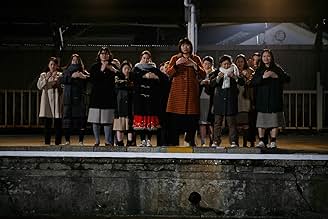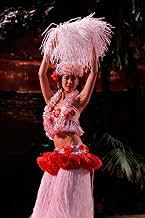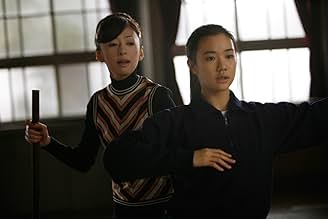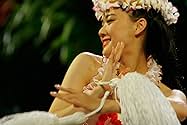Hura gâru
- 2006
- 2h 1m
IMDb RATING
7.0/10
2.3K
YOUR RATING
Young women in a small Japanese town look to revive their home's declining fortunes by building a Hawaiian village tourist attraction.Young women in a small Japanese town look to revive their home's declining fortunes by building a Hawaiian village tourist attraction.Young women in a small Japanese town look to revive their home's declining fortunes by building a Hawaiian village tourist attraction.
- Awards
- 23 wins & 8 nominations total
Hiroki Miyake
- Mitsuo Inokari
- (as Kojo Miyake)
Hiroshi Ôkôchi
- Coal Miners' Union Offical
- (as Hiroshi Ohkôchi)
- Director
- Writers
- All cast & crew
- Production, box office & more at IMDbPro
Featured reviews
I saw 'Hula Girl' at the Toronto International Film Festival with the affable director Lee Sang-Il present.
This movie, based on the true story of how a dying coal mining town attempts the preposterous idea of building a taste of Hawaii in the cold town through dancing girls, a huge palm-tree filled centre and an 'outsider' dance teacher from Tokyo.
Almost immediately, you know that this movie will be about the town's struggle to survive pitting the traditional, town-encrusted family against those supporting a potential new way of life. I had thoughts of the Japanese version of 'Shall We Dance' ringing through my mind, but perhaps the dancing is the furthest you can compare between the movies. The emotional depth of the movie was somewhat unexpected...sadness, some corniness, some laughter. Yet the movie worked where it needed to, and kept moving at the right pace leaving me at the end feeling like I had seen everything that had happened. Except that at the end, I had been so entranced with the characters I was wondering how they, themselves turned out.
The movie pulled me in nicely with a strong story that was well developed and a really good watch.
If you're looking for something a little different, and open to learning a little bit about life in a small Japanese town in the 1960s, I think this gives you a good feel for the people, the attitudes, and a change that took grip in a dramatic and light-hearted way.
Kudos to the director and production team!
This movie, based on the true story of how a dying coal mining town attempts the preposterous idea of building a taste of Hawaii in the cold town through dancing girls, a huge palm-tree filled centre and an 'outsider' dance teacher from Tokyo.
Almost immediately, you know that this movie will be about the town's struggle to survive pitting the traditional, town-encrusted family against those supporting a potential new way of life. I had thoughts of the Japanese version of 'Shall We Dance' ringing through my mind, but perhaps the dancing is the furthest you can compare between the movies. The emotional depth of the movie was somewhat unexpected...sadness, some corniness, some laughter. Yet the movie worked where it needed to, and kept moving at the right pace leaving me at the end feeling like I had seen everything that had happened. Except that at the end, I had been so entranced with the characters I was wondering how they, themselves turned out.
The movie pulled me in nicely with a strong story that was well developed and a really good watch.
If you're looking for something a little different, and open to learning a little bit about life in a small Japanese town in the 1960s, I think this gives you a good feel for the people, the attitudes, and a change that took grip in a dramatic and light-hearted way.
Kudos to the director and production team!
Between 1966 and 1970 I was stationed at Misawa AFB in Aomori Prefecture, Japan. I had a car and traveled a lot. Eventually went to the Joban Hawaiian Center at the suggestion of a Japanese friend and fell in love with the place. I made the JHC my main spot for R&R after that and even scheduled several trips there for my coworkers.
This movie is NOT a comedy, in my mind, but a true life story about overcoming tragedy. I went to the JHC very often and the dancers and staff got to know me well. Between performances I often drank coke with the Hula dancers and on one visit I was asked to help a male-female duet with the pronunciation of the words for "The Hawaiian Wedding Song". I watch this movie every chance I get and it always brings tears to my eyes. The Joban Hawaiian center is one of the reasons I eventually spent 30 years teaching English in Japan (returned to the U.S. in Feb. 2014).
This movie is NOT a comedy, in my mind, but a true life story about overcoming tragedy. I went to the JHC very often and the dancers and staff got to know me well. Between performances I often drank coke with the Hula dancers and on one visit I was asked to help a male-female duet with the pronunciation of the words for "The Hawaiian Wedding Song". I watch this movie every chance I get and it always brings tears to my eyes. The Joban Hawaiian center is one of the reasons I eventually spent 30 years teaching English in Japan (returned to the U.S. in Feb. 2014).
This film was quite dramatic. There were some very emotional scenes. I often cried. The dance scenes were simple (subtle) and quite appropriate. We get a realistic glimpse into the Japanese homes, the workplace and the local eating place, as well as some Japanese customs (particularly the sumimasen), in this small 1960's Japanese town.
A Hula Dance teacher is brought to a small mining town to teach Hula to the young girls in hopes that the town will create a Hawaiian tourist attraction in the near future. The young girls are presented with an opportunity to change their fate (and unknowingly, the fate of their town). The majority of the townsfolk are in complete opposition, putting the young girls at serious odds with their families and the society in which the live.
This story is loaded with dramatic personal interactions between characters. Many of the characters are developing (people becoming better persons). The sensei undergoes a bit of an attitude adjustment, inspired by her dancers. However, it is not until a climactic Hula Show that we realize the true heroine of Hula Girls.
I shall recommend this to all aspiring dancers. This review was based on the Japanese film with English subtitles.
A Hula Dance teacher is brought to a small mining town to teach Hula to the young girls in hopes that the town will create a Hawaiian tourist attraction in the near future. The young girls are presented with an opportunity to change their fate (and unknowingly, the fate of their town). The majority of the townsfolk are in complete opposition, putting the young girls at serious odds with their families and the society in which the live.
This story is loaded with dramatic personal interactions between characters. Many of the characters are developing (people becoming better persons). The sensei undergoes a bit of an attitude adjustment, inspired by her dancers. However, it is not until a climactic Hula Show that we realize the true heroine of Hula Girls.
I shall recommend this to all aspiring dancers. This review was based on the Japanese film with English subtitles.
My impression of the hula dance - random wave movement of the hands by tanned girls wearing straw skirts with a big flower on the head. That was before this movie.
The Hula Girls, a heartwarming comedy from Japan, tells about the craft, emotions and passion behind this dance. Being Hawaii has almost nothing to do with a depressed and cold mining town, almost devoid of colours and warmth. However, a group of girls from the conservatives to bespectacled obasan, decided to learn the dance to develop this declining town into a Hawaiian Village.
This is a daunting task to a Tokyo dance teacher (wonderfully played by Yasuko Matsuyuki) and a demoralizing act to the conservative skeptics in the small village.
A story about going against all odds may remind you of another Japanese comedy, The Swing Girls. Both movies boost great energy, lovely music and can put a smile on your face.
As Japan official's entry to the 2007 Academy Awards Best Foreign Film, The Hula Girls is not only entertaining, but motivational. It may be small in ambition, but big in what in can achieve to inspire people to chance, accept, fall and rise again.
It is funny and touching at the small time, pushing your heartstrings (and tear ducts) with the girls' triumph over people who do not believe in them, which includes themselves.
With its infectious energy and stirring movements, this hula dance deserves a round of applause and bouquets.
http://themovieclub.blogspot.com
The Hula Girls, a heartwarming comedy from Japan, tells about the craft, emotions and passion behind this dance. Being Hawaii has almost nothing to do with a depressed and cold mining town, almost devoid of colours and warmth. However, a group of girls from the conservatives to bespectacled obasan, decided to learn the dance to develop this declining town into a Hawaiian Village.
This is a daunting task to a Tokyo dance teacher (wonderfully played by Yasuko Matsuyuki) and a demoralizing act to the conservative skeptics in the small village.
A story about going against all odds may remind you of another Japanese comedy, The Swing Girls. Both movies boost great energy, lovely music and can put a smile on your face.
As Japan official's entry to the 2007 Academy Awards Best Foreign Film, The Hula Girls is not only entertaining, but motivational. It may be small in ambition, but big in what in can achieve to inspire people to chance, accept, fall and rise again.
It is funny and touching at the small time, pushing your heartstrings (and tear ducts) with the girls' triumph over people who do not believe in them, which includes themselves.
With its infectious energy and stirring movements, this hula dance deserves a round of applause and bouquets.
http://themovieclub.blogspot.com
Make no mistake about it, this is a Japanese comedy, with few ties to Hawaii. But that doesn't take away from the fact the film is wonderfully scored, believably acted, and a fun, entertaining movie. Screened for the first time in the U.S. in October 2006 as the finale gala extravaganza at the Hawaii International Film Festival (#1 Asian festival & one of world's 10 best overall now), many hula teachers and Hawaii fans may have feared this movie might take a less- than-serious-enough view of the sacred Hawaiian dance. But, upon viewing this light-hearted comedy, critics had to sit back and appreciate just how loyal the film remained to the Japanese interpretation of hula. Japanese view hula as a dance, and Hawaii as a warm tropical paradise in much the same way American filmmakers viewed Hawaii in the 1950s. Viewers, even kumu hula and critics, shouldn't forget that this is a film about that Japanese interpretation - at that time, and not impose upon it the serious more cultural aspects a current movement in Hawaii is bringing back to the dance. In fact, the director of "Hula Garu" successfully gets away with this by making the film a comedy, and never trying to delve into the historical, religious, or other cultural dimensions of hula. While not true to today's view of hula in Hawaii, this film is not about today, or Hawaii. It's about an obscure little town in northern Japan that created a Hawaiian village concept, complete with its own hula troupe to attract tourists and save the town from extinction. Several heart warming moments in this 'To Sir With Love,' teacher-conquers- impossible-odds themed story bring tears to the spectators' eyes. And the music could hardly have been more perfect to help accentuate those emotional moments. Ukulele virtuoso Jake Shimabukuro's score is perfect, and likely to win awards, and possibly even help make Jake a household name on the U.S. mainland, as it already has become in many circles in Japan. The film's screenplay successfully draws the audience into the characters in a way that forces even the most critical hula fans to forgive the film's small imperfections. The only strong disappointment I had about the film was how it confused hula and Tahitian dancing. On the other hand, that's a common misconception that all Hawaii visitors make, since hula troups almost always perform both types of dances in public. So, in a sense, the film is true to the way Japanese and tourists perceive hula, if not to hula itself. This film is not a film about Hawaii or hula dancing; but a comedy about how Japanese have adopted this wonderful dance in its own way, while respecting the Hawaiian culture in doing so. Keeping that in mind, viewers will have little to critique and everything to enjoy about this film, the acting, and the wonderful music. Overall, this is a fun, enjoyable family movie which deserves to be seen on the big screen. Don't wait to rent the video. See it in a theater and feel the energy, the music, and the strange story that began Japan's growing love for Hawaii's greatest export.
Did you know
- TriviaNone of the actresses had any dance training prior to the film, so they trained for three months.
Details
- Release date
- Country of origin
- Official sites
- Language
- Also known as
- Hula Girls
- Filming locations
- Production companies
- See more company credits at IMDbPro
Box office
- Gross worldwide
- $9,483,095
- Runtime
- 2h 1m(121 min)
- Color
- Sound mix
- Aspect ratio
- 1.85 : 1
Contribute to this page
Suggest an edit or add missing content
























